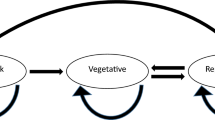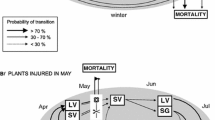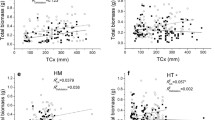Abstract
Disturbed communities are observed to be more susceptible to invasion by exotic species, suggesting that some attributes of the invaders may interact with disturbance regime to facilitate invasion success. Alternanthera philoxeroides, endemic to South America, is an amphibious clonal weed invading worldwide. It tends to colonize disturbed habitats such as riparian zones, floodplain wetlands and agricultural areas. We developed an analytical model to explore the interactive effects of two types of physical disturbances, shoot mowing and root fragmentation, on biomass production dynamics of A. philoxeroides. The model is based on two major biological assumptions: (1) allometric growth of root (belowground) vs. shoot (aboveground) biomass and (2) exponential regrowth of shoot biomass after mowing. The model analysis revealed that the interaction among allometric growth pattern, shoot mowing frequency and root fragmentation intensity might lead to diverse plant ‘fates’. For A. philoxeroides whose root allocation decreases with growing plant size, control by shoot mowing was faced with two dilemmas. (1) Shoot regrowth can be effectively suppressed by frequent mowing. However, frequent shoot mowing led to higher biomass allocation to thick storage roots, which enhanced the potential for faster future plant growth. (2) In the context of periodic shoot mowing, individual shoot biomass converged to a stable equilibrium value which was independent of the root fragmentation intensity. However, root fragmentation resulted in higher equilibrium population shoot biomass and higher frequency of shoot mowing required for effective control. In conclusion, the interaction between allometric growth and physical disturbances may partially account for the successful invasion of A. philoxeroides; improper mechanical control practices could function as disturbances and result in exacerbated invasion.





Similar content being viewed by others
References
Davis MA, Grime JP, Thompson K (2000) Fluctuating resources in plant communities: a general theory of invasibility. J Ecol 88:528–534. doi:10.1046/j.1365-2745.2000.00473.x
Ferraro DO, Oesterheld M (2002) Effect of defoliation on grass growth: a quantitative review. Oikos 98:125–133. doi:10.1034/j.1600-0706.2002.980113.x
Geng YP, Pan XY, Xu CY, Zhang WJ, Li B, Chen JK (2006) Phenotypic plasticity of invasive Alternanthera philoxeroides in relation to different water availability, compared to its native congener. Acta Oecol 30:380–385. doi:10.1016/j.actao.2006.07.002
Geng YP, Pan XY, Xu CY, Zhang WJ, Li B, Chen JK (2007a) Plasticity and ontogenetic drift of biomass allocation in response to above- and below-ground resource availabilities in perennial herbs: a case study of Alternanthera philoxeroides. Ecol Res 22:255–260. doi:10.1007/s11284-006-0017-9
Geng YP, Pan XY, Xu CY, Zhang WJ, Li B, Chen JK et al (2007b) Phenotypic plasticity rather than locally adapted ecotypes allows the invasive alligator weed to colonize a wide range of habitats. Biol Invasions 9:245–256. doi:10.1007/s10530-006-9029-1
Hierro JL, Maron JL, Callaway RM (2005) A biogeographical approach to plant invasions: the importance of studing exotics in their introduced and native range. J Ecol 93:5–15. doi:10.1111/j.0022-0477.2004.00953.x
Hilbert DW, Swift DM, Detling JK, Dyer MI (1981) Relative growth rates and the grazing optimization hypothesis. Oecologia 51:14–18. doi:10.1007/BF00344645
Holm L, Doll J, Holm E, Pancho JV, Herberger JP (1997) World weeds: natural histories and distribution. Wiley, New York
Iwasa Y, Kubo T (1997) Optimal size of storage for recovery after unpredictable disturbances. Evol Ecol 11:41–65. doi:10.1023/A:1018483429029
Jia X, Fu DJ, Pan XY, Li B, Chen JK (2007) Growth pattern of alligator weed (Alternanthera philoxeroides) in terrestrial habitats. Biodivers Sci 15:241–246. doi:10.1002/cbdv.200790029. (in Chinese with English abstract)
Julien MH, Chan RR (1992) Biological control of alligator weed: unsuccessful attempts to control terrestrial growth using the flea beetle Disonycha argentinensis. Entomophaga 37:215–221. doi:10.1007/BF02372420
Julien MH, Skarratt B, Maywald GF (1995) Potential geographical distribution of alligator weed and its biological control by Agasicles hygrophila. J Aquat Plant Manage 33:55–60
Lake JC, Leishman MR (2004) Invasion success of exotic plants in natural ecosystems: the role of disturbance, plant attributes and freedom from herbivores. Biol Conserv 117:215–226. doi:10.1016/S0006-3207(03)00294-5
Leishman MR, Thompson VP (2005) Experimental evidence for the effects of additional water, nutrients and physical disturbance on invasive plants in low fertility Hawkesbury Sandstone soils, Sydney, Australia. J Ecol 93:38–49
Li ZY, Xie Y (2002) Invasive alien species in china. Forestry Publishing Company of China, Beijing. (in Chinese)
Li B, Shibuya T, Yogo Y, Hara T (2004) Effects of ramet clipping and nutrient availability on growth and biomass allocation of yellow nutsedge. Ecol Res 19:603–612. doi:10.1111/j.1440-1703.2004.00685.x
Lonsdale WM (1999) Global patterns of plant invasions and the concept of invasibility. Ecology 80:1522–1536
Louda SM, Pemberton RW, Johnson MT, Follett P (2003) Nontarget effects: the Achilles’s heel of biological control? Retrospective analyses to reduce risk associated with biocontrol introductions. Annu Rev Entomol 48:365–396. doi:10.1146/annurev.ento.48.060402.102800
Mack RN, Simberloff D, Lonsdale WM, Evans H, Clout M, Bazzaz FA (2000) Biotic invasions: causes, epidemiology, global consequences, and control. Ecol Appl 10:689–710. doi:10.1890/1051-0761(2000) 010[0689:BICEGC]2.0.CO;2
McNaughton SJ (1983) Compensatory plant growth as a response to herbivory. Oikos 40:329–336. doi:10.2307/3544305
Minchinton TE, Bertness MD (2003) Disturbance-mediated competition and the spread of Phragmites austrialis in a coastal marsh. Ecol Appl 13:1400–1416. doi:10.1890/02-5136
Pan XY (2005) Canopy constant: growth responses of invasive Alternanthera philoxeroides to shading, density and disturbance. Fudan Univ, Shanghai. (in Chinese)
Pan XY, Geng YP, Zhang WJ, Li B, Chen JK (2006) The influence of abiotic stress and phenotypic plasticity on the distribution of invasive Alternanthera philoxeroides along a riparian zone. Acta Oecol 30:333–341. doi:10.1016/j.actao.2006.03.003
Pan XY, Geng YP, Sosa A, Zhang WJ, Li B, Chen JK (2007) Invasive Alternanthera philoxeroides: biology, ecology and management. Acta Phytotaxon Sin 45:884–900. doi:10.1360/aps06134
Raghu S, Dhileepan K, Scanlan JC (2007) Predicting risk and benefit a priori in biological control of invasive plant species: a systems modelling approach. Ecol Modell 208:247–262. doi:10.1016/j.ecolmodel.2007.05.022
Reich PB, Walters MB, Krause SC, Vanderklein DW, Raffa KF, Tabone T (1993) Growth, nutrition and gas exchange of Pinus resinosa following artificial defoliation. Trees (Berl) 7:67–77. doi:10.1007/BF00225472
Ruesink JL, Collada-Vides L (2006) Modeling the increase and control of Caulerpa taxifolia, an invasive marine macroalga. Biol Invasions 8:309–325. doi:10.1007/s10530-004-8060-3
Sainty G, McCorkelle G, Julien MH (1998) Control and spread of alligator weed Alternanthera philoxeroides (Mart.) Griseb., in Australia: lessons for other regions. Wetlands Ecol Manage 5:195–201. doi:10.1023/A:1008248921849
Sakai AK, Allendorf FW, Holt JS, Lodge DM, Molofsky J, With KA et al (2001) The population biology of invasive species. Annu Rev Ecol Syst 32:305–332. doi:10.1146/annurev.ecolsys.32.081501.114037
Schooler SS, Yeates AG, Wilson JRU, Julien MH (2007) Herbivory, mowing, and herbicides differently affect production and nutrient allocation of Alternanthera philoxeroides. Aquat Bot 86:62–68. doi:10.1016/j.aquabot.2006.09.004
Sharov AA, Liebhold AM (1998) Model of slowing the spread of gypsy moth (Lepidoptera: Lymantriidae) with a barrier zone. Ecol Appl 8:1170–1179. doi:10.1890/1051-0761(1998) 008[1170:MOSTSO]2.0.CO;2
Spencer NR, Coulson JR (1976) The biological control of alligator weed, Alternanthera philoxeroides, in the United States of America. Aquat Bot 2:177–190. doi:10.1016/0304-3770(76)90019-X
Stoll P, Egli P, Schmid B (1998) Plant foraging and rhizome growth patterns of Solidago altissima in response to mowing and fertilizer application. J Ecol 86:341–354. doi:10.1046/j.1365-2745.1998.00263.x
Suzuki JI, Stuefer JF (1999) On the ecological and evolutionary significance of storage in clonal plants. Plant Species Biol 14:11–17. doi:10.1046/j.1442-1984.1999.00002.x
Taylor CM, Hastings A (2004) Finding optimal control strategies for invasive species: a density-structured model for Spartina alterniflora. J Appl Ecol 41:1049–1057. doi:10.1111/j.0021-8901.2004.00979.x
Thornton B, Millard P (1996) Effects of severity of defoliation on root functioning in grasses. J Range Manage 49:443–447. doi:10.2307/4002927
Weiner J (2004) Allocation, plasticity and allometry in plants. Perspect Plant Ecol Evol Syst 6:207–215. doi:10.1078/1433-8319-00083
West GB, Brown JH, Enquist BJ (1999) A general model for the structure and allometry of plant vascular systems. Nature 400:664–667. doi:10.1038/23251
Wilson MV, Clark DL (2001) Controlling invasive Arrhenatherum elatius and promoting native prairie grasses through mowing. Appl Veg Sci 4:129–138
Wilson JRU, Yeates A, Schooler S, Julien MH (2007) Rapid response to shoot removal by the invasive wetland plant, alligator weed (Alternanthera philoxeroides). Environ Exp Bot 60:20–25. doi:10.1016/j.envexpbot.2006.06.003
Wright JT, Davis AR (2006) Demographic feedback between clonal growth and fragmentation in an invasive seaweed. Ecology 87:1744–1754. doi:10.1890/0012-9658(2006)87[1744:DFBCGA]2.0.CO;2
Acknowledgements
We thank Prof. Yongji Tan and Dr. Yichao Zhu (School of Mathematical Science, Fudan University) for helpful discussions. We also appreciate the anonymous reviewers offering insightful comments. This study was financially supported by the National Natural Science Foundation of China (30400052) and National Basic Research Program of China (2006CB403305).
Author information
Authors and Affiliations
Corresponding author
Appendix 1: Derivation of the general equations and the condition for S n = S n−1 and P n = P n−1
Appendix 1: Derivation of the general equations and the condition for S n = S n−1 and P n = P n−1
At individual level
Individual shoot biomass at the first mowing (time 0, see Fig. 2) is S 0. According to Eq. 5, shoot biomass at the second mowing (time T), S 1, is
Similarly, at the third mowing (time 2T), S 2 is
and at the fourth mowing (time 3T), S 3 is
Conclusively, individual shoot biomass at the (n + 1) th mowing (time nT), S n, is given by
Now the condition under which S n = S n−1 turns out to be equal to
This expression can be simplified to
After incorporating Eq. 1 into the above equation, we can obtain Eq. 9:
At population level
Population shoot biomass at the first mowing (time 0) is P 0. According to Eq. 7, population shoot biomass at the second mowing (time T), P 1, is
Similarly, at the third mowing (time 2T), P 2 is
and at the fourth mowing (time 3T), P 3 is
In conclusion, the population shoot biomass at the (n + 1) th mowing (time nT), P n, is given by
Now the condition under which P n = P n−1 is equal to
This expression can be simplified to
further to
After incorporating Eq. 1 into the above equation, we arrive at Eq. 9 again:
Rights and permissions
About this article
Cite this article
Jia, X., Pan, X.Y., Li, B. et al. Allometric growth, disturbance regime, and dilemmas of controlling invasive plants: a model analysis. Biol Invasions 11, 743–752 (2009). https://doi.org/10.1007/s10530-008-9288-0
Received:
Accepted:
Published:
Issue Date:
DOI: https://doi.org/10.1007/s10530-008-9288-0




